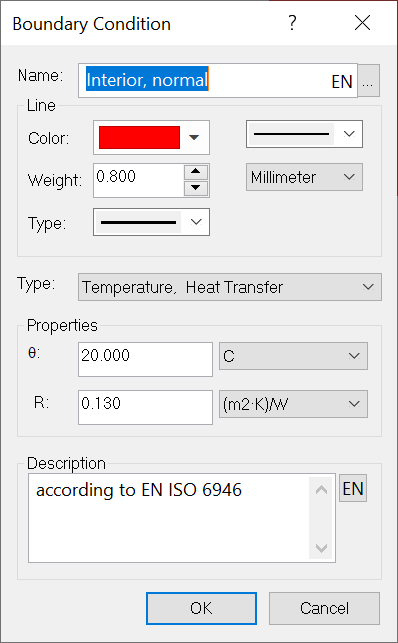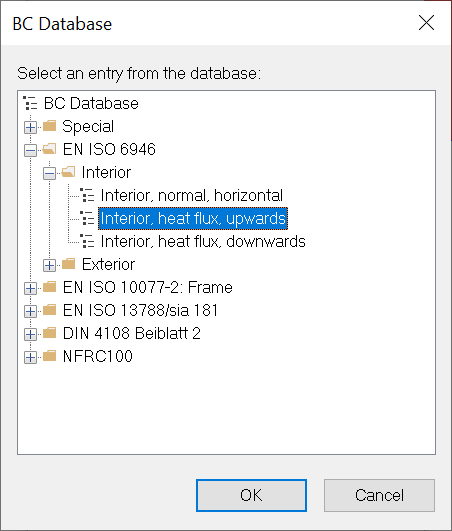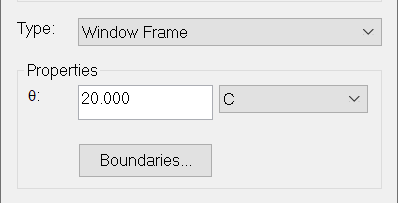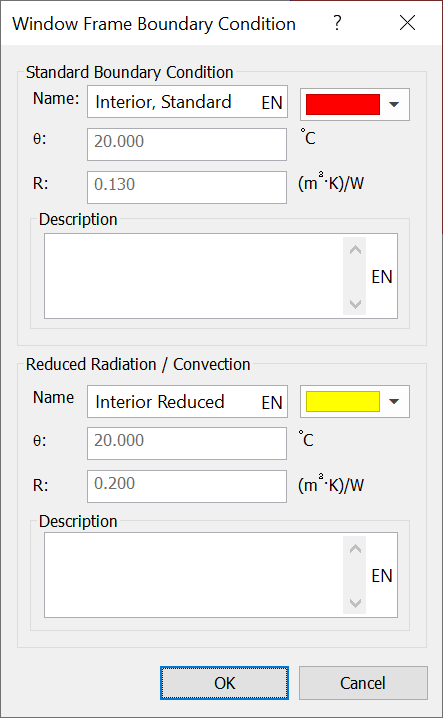Description
The "Boundary Condition" dialog window contains several fields to define or adjust boundary conditions. This dialog can be activated from the Boundary Conditions flyout.
Figure 1: Boundary Conditions dialog window |
|
|
|
Figure 3: Window Frame Type |
Figure 4: Window Frame boundary conditions dialog window |
|
Fields
Name |
Here the name of the boundary condition is defined. You cannot leave the field blank. And the name must be unique, i.e. it cannot be identical to the name of another boundary condition on the same page. Aside from these restrictions, you can choose any name. Click on the language abbreviation in this field to set the name in all supported languages. |
... |
After clicking on the "..." button, a dialog window appears with the database. From the database, you can choose an entry. The boundary condition properties will be assumed. |
Color |
Determines the boundary condition color, which will appear in the model. |
Type |
Type of boundary condition. The following types of boundary conditions are supported: - Temperature, h-value: For boundaries, where the air temperature and the heat transfer coefficient are present. This type of boundary condition is used for normal boundary conditions. - Temperature (Dirichlet): For boundaries, where the surface temperature is given (e.g. the entering temperature for a floor heating system). - Heat Flux (Neumann): For boundaries, where the heat flux for a surface is given. - Heat Flux, Temperature (Cauchy): For boundaries, where the heat flux and the surface temperature are given. - Radiation: black body: For inner boundaries where the air and radiation temperature and the convective heat transfer coefficient are given. The radiation part of the heat transport is calculated idealized. - Radiation: automatic enclosure: For inner boundaries where the air and radiation temperature and the convective heat transfer coefficient are given. The radiation part of the heat transport is calculated using an automatically generated room geometry. - Source/Sink: For the performance of linear sources and sinks (see Heat Source Tool). - Radiation: For the definition of surface radiation properties (emissivities) of air cavities, if the surface properties are calculated by flixo (cf. Option dialog window cavities). - Window Frame: For interior boundaries when calculating the frame U-value according to EN ISO 10077-2 (cf. lesson 4). The line properties, the name of the 2 dependent boundary conditions for normal domains, and the domains with reduced h-values can be adjusted by clicking on the Boundaries button and entering the values in the dialog window (see Figure 4) that appears. |
q (Neumann, Cauchy) |
Heat stream density on the surface. |
θ (Cauchy, Dirichlet, Clima) |
Surface temperature (for Dirichlet BC or Cauchy BC) or air temperature (for Climate BC and window frame BC). |
h |
Heat transfer coefficient The heat transfer resistance R can optionally be entered at this point as well. The settings can be determined in the Options dialog window. |
ε |
Emissivity between 0 and 1. |
Description |
Additional commentary Click on the language abbreviation in this field to set the name in all supported languages. |
The values must be entered in the displayed units. You can change the display in the Basic Units Options dialog window.



